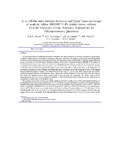Please use this identifier to cite or link to this item:
http://hdl.handle.net/10311/742| Title: | A ca. 200Ma hiatus between the Lower and Upper Transvaal Groups of southern Africa: SHRIMP U–Pb detrital zircon evidence from the Segwagwa Group, Botswana: Implications for Palaeoproterozoic glaciations |
| Authors: | Mapeo, R.B.M. Armstrong, R.A. Kampunzu, A.B. Modisi, M.P. Ramokate, L.V. Modie, B.N.J. |
| Keywords: | Transvaal Supergroup Segwagwa/Pretoria Group Botswana Southern Africa Detrital zircon geochronology Glacial implications |
| Issue Date: | 2006 |
| Publisher: | Elsevier www.elsevier.com/locate/epsl |
| Citation: | Mapeo, R.B.M. et al (2006), A ca. 200 Ma hiatus between the Lower and Upper Transvaal Groups of Southern Africa: SHRIMP U–Pb detrital zircon evidence from the Segwagwa Group, Botswana: Implications for Palaeoproterozoic glaciations, Earth and Planetary Science Letters, Vol. 244, pp.113–132 |
| Abstract: | The Segwagwa Group of southeastern Botswana, a correlate of the Pretoria Group of the Transvaal Supergroup of South Africa, consists of a major sequence of siliciclastic sedimentary rocks, minor carbonates and basaltic to andesitic lavas and tuffs straddling the Western and Central Domains of the Kaapvaal Craton. The Segwagwa Group unconformably overlies the Taupone Dolomite Group, a correlative of the South African Chuniespoort/Ghaap Groups of the Transvaal Supergroup. SHRIMP U–Pb analyses of 123 detrital zircons from the top, middle and bottom of the Segwagwa Group sedimentary rocks include 96 concordant to nearconcordant zircons defining three main age groups: >3.0–2.9 Ga (n=12), 2.8–2.5 Ga (n=27) and 2.45–2.20 Ga (n=57). The ≥2.90 Ga zircons were sourced from granitoids emplaced before and around 2915±12 Ma and are related to the amalgamation of the Western, Northern and Central Domains of the Kaapvaal Craton. Concordant zircons with a mean age of 2781±8 Ma originate from the Gaborone Igneous Complex. The detrital zircons in the range 2.7–2.5 Ga were likely sourced from the Kalahari continental fragment made up of the Kaapvaal Craton, Limpopo Belt and the Zimbabwe Craton, specifically from the Limpopo Belt and/or the Zimbabwe Craton where igneous rocks in this age range are widespread. The igneous sources for the Palaeoproterozoic (ca. 2.45–2.20 Ga) zircons are difficult to identify since igneous rocks in that age are not widely known or documented by reliable dates in the Kalahari Craton. The youngest zircons of ca. 2.2 Ga occur in all the sandstones and form the main group (N90%) in the sample from the top of the Segwagwa Group. The youngest detrital zircon of 2193±20 Ma sets the maximum time of deposition of the Segwagwa Group. Published data suggest that the minimum deposition age of Chuniespoort/Ghaap Group sedimentary rocks is 2431±31 Ma [D.R. Nelson, Compilation of SHRIMP U-Pb zircon Geochronological Data, 1996 Record 1997/2, pp. 189, Western Australia Geological Survey, 1997.]. Therefore, the unconformity between the Lower and Upper Transvaal represents a ∼200 Ma hiatus, and the lithostratigraphic units on the two sides of the unconformity should not be grouped in the same supergroup. Detrital zircon ages suggest that the time of deposition of the Segwagwa/Pretoria Group which ranges from ca. 2.40 to 2.20 Ga is coeval with the Palaeoproterozoic global glacial deposits in North America, Australia and Fennoscandia; and with sedimentary rocks from the Palaeoproterozoic Magondi Belt. Therefore, the Segwagwa/Pretoria Group and the Magondi metasedimentary succession were deposited during the first global glacial period, are possibly related to the same geodynamic cycle, and should be part of the same supergroup. |
| URI: | http://hdl.handle.net/10311/742 |
| ISSN: | 0012-821X |
| Appears in Collections: | Research articles (Dept of Geology) |
Files in This Item:
| File | Description | Size | Format | |
|---|---|---|---|---|
| Mapeo2006Transvaal Groups.pdf | 1.95 MB | Adobe PDF |  View/Open |
Items in DSpace are protected by copyright, with all rights reserved, unless otherwise indicated.
